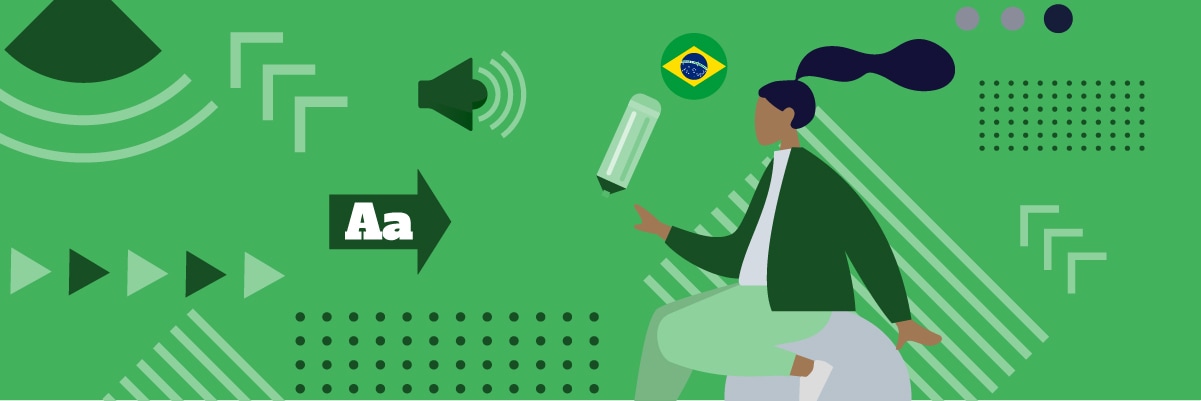No, my friends, it isn’t, I’m sorry. It wasn’t my intention to disabuse you of any false notions so early, but I love being to-the-point. You see, the most prevalent language across Latin America is indeed Spanish, as is the case for my home country, Argentina. But, Brazil — a country with over 210 million inhabitants — likes doing its own thing. Therefore, you’ll be surprised to know that the Brazil language is actually its own spin on Portuguese. Huh! If you’re ready to learn all about it and sprinkle your life with a little jogo bonito, read on!
But hold on just one minute, buster! What’s all this hubbub about the Brazil language about? Is this some sort of PSA to clue people in about language diversity in Latin America? Yes and no; you see, while it’s all well and good to know about multiple languages, the Brazilian market is not exactly chopped liver. With a GDP of 1.9 trillion dollars, you’d be wise to give it some serious consideration.
But, be aware that Brazilians are a discerning, proud bunch who don’t like being pandered to. If you’re thinking about talking to them on their own terms, this is the right article for you. So, let’s take care of the basics first, and work our way up from there.
Basics of the Brazil Language
As we know, the history of the Americas is also the history of Western European colonialism. In particular, most of Latin America was under the rule of the Spanish crown, so it’s no surprise that most of the former colonies speak Spanish. But Brazil was unique in the sense that it was under the rule of the Portuguese for many years. Therefore, the Brazil language ended up being a unique mix of Portuguese, African, and other influences.
The result is quite unlike any other form of Portuguese out there and also ended up being the most influential form of the language. Nowadays, if you hear Portuguese, it’s most likely from Brazil. It also doesn’t hurt that Portuguese is the sixth most popular language in the world right now. 280 million people speak it worldwide, and — you’ve guessed it — 210+ hail from beautiful Brazil, although a total of 10 countries speak it.
And, with Brazil having one of the world’s largest economies, you’d be right in thinking that it’s a good idea to acquaint yourself with it fast.

Some History
So, we’ve established that Brazil speaks Portuguese due to the Portuguese colonization of the Americas. The Portuguese and Spaniards were so cocky that they even drafted a treatise, the Treaty of Tordesillas in 1494 to divide the world into Castillian and Portuguese hemispheres. At one point, Portugal had control over Venezuela, Uruguay, Brazil, Colonia do Sacramento, and Guanare. Plus, they made a concerted effort at colonizing North America (Nova Scotia and Newfoundland and Labrador in Canada), but it didn’t amount to much.
It comes as a surprise, then, to know that Portuguese wasn’t the original Brazil language, at least not at first. Wikipedia to the rescue!
The first wave of Portuguese-speaking immigrants settled in Brazil in the 16th century, but the language was not widely used then. For a time Portuguese coexisted with Língua Geral[9]—a lingua franca based on Amerindian languages that was used by the Jesuit missionaries—as well as with various African languages spoken by the millions of slaves brought into the country between the 16th and 19th centuries. By the end of the 18th century, Portuguese had affirmed itself as the national language. Some of the main contributions to that swift change were the expansion of colonization to the Brazilian interior, and the growing numbers of Portuguese settlers, who brought their language and became the most important ethnic group in Brazil.
But this wasn’t really enough to change the tide by itself. The new Portuguese settlers weren’t about to sit around and wait for change to happen. That’s just not the way they rolled.
Taking the Bull by the Horns
At the start of the 18th century, the Portuguese government wanted to take control. “He who controls the language controls the masses,” goes the adage by Saul Alinsky. And the Portuguese were not exactly the passive type. And, since Portugal had several lands in dispute with Spain, they also had plenty of skin in the game. They had signed several treaties that ensured that the lands would go to those who occupied them. What better way to ensure that went in Portugal’s favor than to fill the land with Portuguese-speaking settlers?
Thus, under the reign of the Marquis of Pombal, Brazil started favoring the use of Portuguese. Well, “favoring” is kind of a weasel term here. More like “kicked out Lingua-Geral-speaking Jesuit missionaries and banned the use of Nhengatu, or Lingua Franca.” These guys certainly didn’t mess around.
And thus, Portuguese was and is the main language of Brazil. Even after attempted French colonization and many waves of non-Portuguese-speaking immigrants, it held strong. After one or two generations, the children of immigrants had completely acclimated to the unique lilt of the Brazil language.
Brazil Language – Characteristics
Brazilian Portuguese is unique mainly in its pronunciation and its use of many loanwords. While the Portuguese influence was strong, the Amerindian languages were also an integral part of making the dialect what it is today. Tupi-Guaraní in particular had a very big influence in the naming of places, flora, and fauna.
The Brazilian population was also one of the longest-suffering victims of the scourge of slavery. The country finally abolished it in May of 1888, after 350 years of depending on it as the heart of its economy.
Thus, it’ll probably come as no surprise that the enormous African slave population also had an influence in the shaping of the Brazil language. An estimated 91 million Brazilians are Afro-descendants, per a 2010 census. Most of them identify as preto (black), or mixed-race.
Some of the loanwords from African dialects include:
- Food: quitute, quindim, acarajé, moqueca;
- Religious concepts: mandinga, macumba, orixá (“orisha“), axé;
- Afro-Brazilian music: samba, lundu, maxixe, berimbau;
- Body-related parts and conditions: banguela (“toothless”), bunda (“buttocks”), capenga (“lame”), caxumba (“mumps”);
- Geographical features: cacimba (“well”), quilombo or mocambo (“runaway slave settlement”), senzala (“slave quarters”);
- Articles of clothing: miçanga (“beads”), abadá (“capoeira or dance uniform”), tanga (“loincloth, thong”);
- Miscellaneous household concepts: cafuné (“caress on the head”), curinga (“joker card“), caçula (“youngest child”, also cadete and filho mais novo), and moleque (“brat, spoiled child”, or simply “child”, depending on the region).
English as an Influence
But, the Brazil language doesn’t come from just Portuguese, African, or Amerindian influences. Portuguese itself has many loanwords from other languages, such as English. It permeates many cultural and sociological concepts and has a huge impact on:
- Technology. (App, mod, layout, winch, forward, relay, home-office, etc.)
- Finance and Commerce. (commodities, debênture, holding, fundo hedge, angel, truste, dumping, CEO, CFO, MBA, etc.)
- Sports. ( surf, skating, futebol, voleibol, wakeboard, gol, goleiro, quíper, chutar, chuteira, time, etc.)
- General cultural concepts. (Gay, cocktail, happy hour, lol, gospel, praise, etc.)
Everywhere You Look, Europeans
You think that I was going to forget about the ubiquitous Italian and Spanish presence in Latin America? Heck, at this point, Brazilians have an easier time understanding Spanish-language films than they do European Portuguese ones. How do you wrap your head around that? Well, it turns out that 5% to 7.5% of the population has ties to Spain, for one. But that alone doesn’t explain the cross-pollination.
It also turns out that around 15% of the Brazilian population has Italian ancestry. That, the Italophile tendencies of most of South America, and the combination of Italian, Spanish, and Portuguese, led to a unique melting pot of influences that could only have happened at that time and place.
And it doesn’t end there. The Brazil language also sports many other loanwords from French, German, and even Japanese! I bet you didn’t know about that one, didja?

So, What’s It All Mean to You?
As I established above, Brazil is home to one of the world’s biggest economies. And I say “biggest,” and not “strongest” because — as is the case throughout Latin America — economic and social inequality is still very much a thing. Still, as you can probably tell, Brazil has plenty to offer in every aspect, be it in the world of sports, media, art, commerce and finance, or anything else.
It’s also a country that’s particularly welcoming to outsiders, owing to its multicultural nature. Especially in the areas of foreign trade and commerce, it’s super-strong, and a very big contender in many areas. Also, it’s very open to foreign-language media, as long as it’s well-translated.
And this brings us to the issue of native translators. If you’re thinking about bringing your content to Brazil, or exporting it from Brazil for the whole world to see, you need a Native Language Translator. That is someone who knows the slang, colloquialisms, and language like their ABCs.
Sure, it doesn’t necessarily have to be someone that was born there and speaks is a native to the Brazilian language. But, it helps. It helps to be constantly exposed to an ever-shifting culture because it gives the translator a much better chance to do their job correctly. I would say that, in 80% of cases, it’s better to go with a native. Still, this is more of a rule of thumb than an iron-clad dictum.
What’s the easiest way to ensure great results? Just give a holler to our pro staff at Bunny Studio. We’ve put together a team of great Brazilian Portuguese experts, and we’re not shy about putting them to work on whatever type of document you need. If you want the best, just get in touch, we’d love to work with you!











